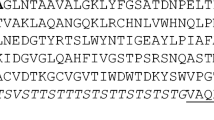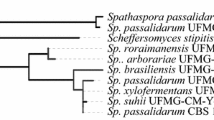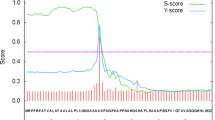Abstract
The anaerobic fungus Piromyces sp. strain E2 metabolizes xylose via xylose isomerase and d-xylulokinase as was shown by enzymatic and molecular analyses. This resembles the situation in bacteria. The clones encoding the two enzymes were obtained from a cDNA library. The xylose isomerase gene sequence is the first gene of this type reported for a fungus. Northern blot analysis revealed a correlation between mRNA and enzyme activity levels on different growth substrates. Furthermore, the molecular mass calculated from the gene sequence was confirmed by gel permeation chromatography of crude extracts followed by activity measurements. Deduced amino acid sequences of both genes were used for phylogenetic analysis. The xylose isomerases can be divided into two distinct clusters. The Piromyces sp. strain E2 enzyme falls into the cluster comprising plant enzymes and enzymes from bacteria with a low G+C content in their DNA. The d-xylulokinase of Piromyces sp. strain E2 clusters with the bacterial d-xylulokinases. The xylose isomerase gene was expressed in the yeast Saccharomyces cerevisiae, resulting in a low activity (25±13 nmol min−1mg protein-1). These two fungal genes may be applicable to metabolic engineering of Saccharomyces cerevisiae for the alcoholic fermentation of hemicellulosic materials.




Similar content being viewed by others
References
Akhmanova A, Voncken FGJ, Harhangi H, Hosea KM, Vogels GD Hackstein JHP (1998) Cytosolic enzymes with a mitochondrial ancestry from the anaerobic chytrid Piromyces sp. E2. Mol Microbiol 30:1017–1027
Akhmanova A, Voncken FGJ, Hosea KM, Harhangi H, Keltjens JT, Op den Camp HJM, Vogels GD, Hackstein JHP (1999) A hydrogenosome with pyruvate formate-lyase: anaerobic chytrid fungi use an alternative route for pyruvate catabolism. Mol Microbiol 32:1103–1114
Amore R, Wilhelm M, Hollenberg CP (1989) The fermentation of xylose—an analysis of the expression of Bacillus and Actinoplanes xylose isomerase genes in yeast. Appl Microbiol Biotechnol 30:351–357
Banerjee S, Archana A, Satyanarayana T (1994) Xylose metabolism in a thermophilic mould Malbranchea pulchella var. sulfurea TMD-8. Curr Microbiol 29:349–352
Borneman WS, Akin DE, Ljungdahl LG (1989) Fermentation products and plant cell wall degrading enzymes produced by monocentric and polycentric anaerobic ruminal fungi. Appl Environ Microbiol 55:1066–1073
Brownlee AG (1994) The nucleic acids of anaerobic fungi. In: Mountfort DO, Orpin CG (eds) Anaerobic fungi. Biology, ecology, and function. Marcel Dekker, New York, pp 241–256
Bruinenberg PM, de Bot PHM, Van Dijken JP, Scheffers WA (1983) The role of the redox balance in the anaerobic fermentation of xylose by yeasts. Eur J Appl Microbiol Biotechnol 18:287–292
Bruinenberg PM, de Bot PHM, Van Dijken JP, Scheffers WA (1984) NADH-linked aldose reductase: the key to alcoholic fermentation of xylose by yeasts. Appl Microbiol Biotechnol 19:256–269
Chirgwin JM, Przybyla AE, MacDonald RJ, Rutter WJ (1979) Isolation of biologically active ribonucleic acid from sources enriched in ribonuclease. Biochemistry 18:5294–5299
Da Silva ACR, Ferro JA, Reinach FC, Farah CS, Furlan LR, Quaggio RB, Monteiro-Vitorello CB, Van Sluys MA, Almeida Jr NF, Alves LMC, do Amaral AM, Bertolini MC, Camargo LEA, Camarotte G, Cannavan F, Cardozo J, Chambergo F, Ciapina LP, Cicarelli RMB, Coutinho LL, Cursino-Santos JR, El-Dorry H, Faria JB, Ferreira AJS, Ferreira RCC, Ferro MIT, Formighieri EF, Franco MC, Greggio CC, Gruber A, Katsuyama AM, Kishi LT, Leite Jr RP, Lemos EGM, Lemos MVF, Locali EC, Machado MA, Madeira AMBN, Martinez-Rossi NM, Martins EC, Meidanis J, Menck CFM, Miyaki CY, Moon DH, Moreira LM, Novo MTM, OkuraVK, Oliveira MC, Oliveira VR, Pereira Jr HA, Rossi A, Sena JAD, Silva C, de Souza RF, Spinola LAF, Takita MA, Tamura RE, Teixeira EC, Tezza RID, Trindade dos Santos M, Truffi D, Tsai SM, White FF, Setubal JC, Kitajima JP (2002) Comparison of the genomes of two Xanthomonas pathogens with differing host specificities. Nature 417:459–463
Devereux J, Haeberli P, Smithies O (1984) A comprehensive set of sequence analysis programs for the VAX. Nucleic Acids Res 12:387–395
Dische Z, Borenfreund E (1951) A new spectrophotometric method for the detection and determination of keto sugars and trioses. J Biol Chem 192:583–587
Felsenstein J (1989) PHYLIP—Phylogeny Interference Package (Version 3.2). Cladistics 5:164–166
Fraenkel DG (1987) Glycolysis, pentose phosphate pathway, and Entner-Doudoroff pathway. In: Neidhardt FC (ed) Escherichia coli and Salmonella typhimurium - cellular and molecular biology. ASM, Washington DC, pp 142–150
Fraser CM, Casjens S, Huang WM, Sutton GG, Clayton RA, Lathigra R, White O, Ketchum KA, Dodson R, Hickey EK, Gwinn M, Dougherty B, Tomb J-F, Fleischmann RD, Richardson D, Peterson J, Kerlavage AR, Quackenbush J, Salzberg S, Hanson M, van Vugt R, Palmer N, Adams MD, Gocayne JD, Weidman J, Utterback T, Watthey L, McDonald L, Artiach P, Bowman C, Garland S, Fujii C, Cotton, MD, Horst K, Roberts K, Hatch B, Smith HO, Venter JC (1997) Genomic sequence of a Lyme disease spirochaete, Borrelia burgdorferi. Nature 390:580–586
Garcia-Vallvé S, Romeu A, Palau J (2000) Horizontal gene transfer of glycosyl hydrolases of the rumen fungi. Mol Biol Evol 17:352–361
Gilbert HJ, Hazlewood GP, Laurie JI, Orpin CG, Xue GP (1992) Homologous catalytic domains in a rumen fungal xylanase—Evidence for gene duplication and prokaryotic origin. Mol Microbiol 6:2065–2072
Hahn-Hägerdal B, Wahlbom CF, Gárdonyi M, van Zyl WH, Cordero Otero RR, Jönsson LF (2001) Metabolic engineering of Saccharomyces cerevisiae for xylose utilization. Adv Biochem Engin Biotechnol 73:53–84
Harhangi HR, Steenbakkers PJM, Akhmanova A, Jetten MSM, van der Drift C, Op den Camp HJM (2002) A highly expressed family 1 β-glucosidase with transglycosylation capacity from the anaerobic fungus Piromyces sp. E2. Biochem Biophys Acta 1574:293–303
Harhangi HR, Akhmanova A, Steenbakkers PJM, Jetten MSM, van der Drift C, Op den Camp HJM (2003) Genomic DNA analysis of genes encoding (hemi-)cellulolytic enzymes of the anaerobic fungus Piromyces sp. E2. Gene (in press)
Henrick K, Collyer CA, Blow DM (1989) Structures of d-xylose isomerase from Arthrobacter strain B3728 containing the inhibitors xylitol and D-sorbitol at 2.5 Å and 2.3 Å resolution, respectively. J Mol Biol 208:129–157
Jeffries TW (1983) Utilization of xylose by bacteria, yeasts, and fungi. Adv Biochem Eng Biotechnol 27:1–32
Jeppsson M, Traff K, Johansson B, Hahn-Hägerdal B, Gorwa-Grauslund MF (2003) Effect of enhanced xylose reductase activity on xylose consumption and product distribution in xylose-fermenting recombinant Saccharomyces cerevisiae. FEMS Yeast Res 3:167–175
Jin YS, Jeffries T (2003) Changing flux of xylose metabolites by altering expression of xylose reductase and xylitol dehydrogenase in recombinant Saccharomyces cerevisiae. Appl Biochem Biotechnol 106:277–286
KanekoT, KotaniH, NakamuraY, Sato S, Asamizu E, Miyajima N, Tabata S (1998) Structural analysis of Arabidopsis thaliana chromosome 5. V. Sequence features of the regions of 1,381,565 bp covered by twenty one physically assigned P1 and TAC clones. J DNA Res 5: 131–145
Kristo P, Saarelainen R, Fagerstrom R, Aho S, Korhola M (1996) Protein purification, and cloning and characterization of the cDNA and gene for xylose isomerase of barley. Eur J Biochem 237:240–246
Kuyper M, Harhangi HR, Stave AK, Winkler AA, Op den Camp HJM, Jetten MSM, de Laat WTAM, den Ridder JJJ, van Dijken JP, Pronk JT (2003) High-level functional expression of a fungal xylose isomerase: the key to efficient alcoholic fermentation of xylose by Saccharomyces cerevisiae? FEMS Yeast Res (in press)
Lowe SE, Theodorou MK, Trinci APJ (1987) Growth and fermentation of an anaerobic fungus on various carbon sources and effect of temperature on development. Appl Environ Microbiol 53:1210–1215
Marvin-Sikkema FD, Richardson AJ, Stewart CS, Gottschal JC, Prins RA (1990) Influence of hydrogen-consuming bacteria on cellulose degradation by anaerobic fungi. Appl Environ Microbiol 56:3793–3797
Marvin-Sikkema FD, Pedro Gomes TM, Grivet JP, Gottschal JC, Prins RA (1993) Characterization of hydrogenosomes and their role in glucose metabolism of Neocallimastix sp. L2. Arch Microbiol 160:388–396
Meaden PG, Aduse-Opoku J, Reizer J, Reizer A, Lanceman YA, Martin MF, Mitchell WJ (1994) The xylose isomerase-encoding gene (xylA) of Clostridium thermosaccharolyticum: Cloning, sequencing and phylogeny of XylA enzymes. Gene 141:97–101
Rawat U, Phadtare S, Deshpande V, Rao M (1996) A novel xylose isomerase from Neurospora crassa. Biotechnol Lett 18:1267–1270
Richard P, Londesborough J, Putkonen M, Kalkkinen N, Penttila M (2001) Cloning and expression of a fungal L-arabinitol 4-dehydrogenase gene. J Biol Chem 276:40631–40637
Rodriguez-Peña JM, Cid VJ, Arroyo J, Nombela C (1998) The YGR194c (XKS1) gene encodes the xylulokinase from the budding yeast Saccharomyces cerevisiae. FEMS Microbiol Lett 162:155–160
Teunissen MJ, Op den Camp HJM (1993) Anaerobic fungi and their cellulolytic and xylanolytic enzymes. Antonie van Leeuwenhoek 63:63–76
Teunissen MJ, Op den Camp HJM, Orpin CG, Huis in 't Veld JHJ, Vogels GD (1991) Comparison of growth characteristics of anaerobic fungi from ruminant and non-ruminant herbivores during growth in a defined medium. J Gen Microbiol 137:1401–1408
Trinci APJ, Davies DR, Gull K, Lawrence MI, Nielsen BB, Rickers A, Theodorou MK (1994) Anaerobic fungi in herbivorous animals. Mycol Res 98:129–152
Vangrysperre W, Van Damme J, Vandekerckhove J, De Bruyne CK, Cornelis R, Kersters-Hilderson H (1989) Localization of the essential histidine and carboxylate group in xylose isomerases. Biochem J 265:699–705
Van Kuyk PA, de Groot MJ, Ruijter GJ, de Vries RP, Visser J (2001) The Aspergillus niger d-xylulose kinase gene is co-expressed with genes encoding arabinan degrading enzymes, and is essential for growth on d-xylose and l-arabinose. Eur J Biochem 268:5414–5423
Walfridsson M, Bao X, Anderlund M, Lilius G, Bulow L, Hahn-Hägerdal B (1996) Ethanolic fermentation of xylose with Saccharomyces cerevisiae harboring the Thermus thermophilus xylA gene, which expresses an active xylose (glucose) isomerase. Appl Environ Microbiol 62:4648–4651
Wang T, Penttila M, Gao P (1999) Expression of xylose-metabolic key genes of Trichoderma reesei on various carbon sources measured by a series of Northern hybridizations. Wei Sheng Wu Xue Bao 39:503–509
Wang T, Penttila M, Gao P, Wang C, Zhong L (1998) Isolation and identification of xylitol dehydrogenase gene from Trichoderma reesei. Chin J Biotechnol 14:179–185
Williams AG, Orpin CG (1987) Polysaccharide degrading enzymes formed by anaerobic rumen fungi grown on a range of carbohydrate substrates. Can J Microbiol 33:418–426
Witteveen CFB, Busink R, van de Vondervoort P, Dijkema C, Swart K, Visser J (1989) l–Arabinose and d-xylose catabolism in Aspergillus niger. J Gen Microbiol 135:2163–2171
Yarlett N, Orpin CG, Munn EA, Yarlett NC, Greenwood CA (1986) Hydrogenosomes in the anaerobic fungus Neocallimastix patriciarum. Biochem J 236:729–739
Zhou LQ, Xue GP, Orpin CG, Black GW, Gilbert HJ, Hazlewood GP (1994) Intronless Celb from the anaerobic fungus Neocallimastix patriciarum encodes a modular family A endoglucanase. Biochem. J 297:359–364
Acknowledgements
We thank Nick van Bakel for excellent technical assistance with the biochemical work and Royal Nedalco B.V. for support. We are grateful to Peter Steenbakkers and Jan Keltjens for critically reading the manuscript and stimulating discussions.
Author information
Authors and Affiliations
Corresponding author
Rights and permissions
About this article
Cite this article
Harhangi, H.R., Akhmanova, A.S., Emmens, R. et al. Xylose metabolism in the anaerobic fungus Piromyces sp. strain E2 follows the bacterial pathway. Arch Microbiol 180, 134–141 (2003). https://doi.org/10.1007/s00203-003-0565-0
Received:
Revised:
Accepted:
Published:
Issue Date:
DOI: https://doi.org/10.1007/s00203-003-0565-0




